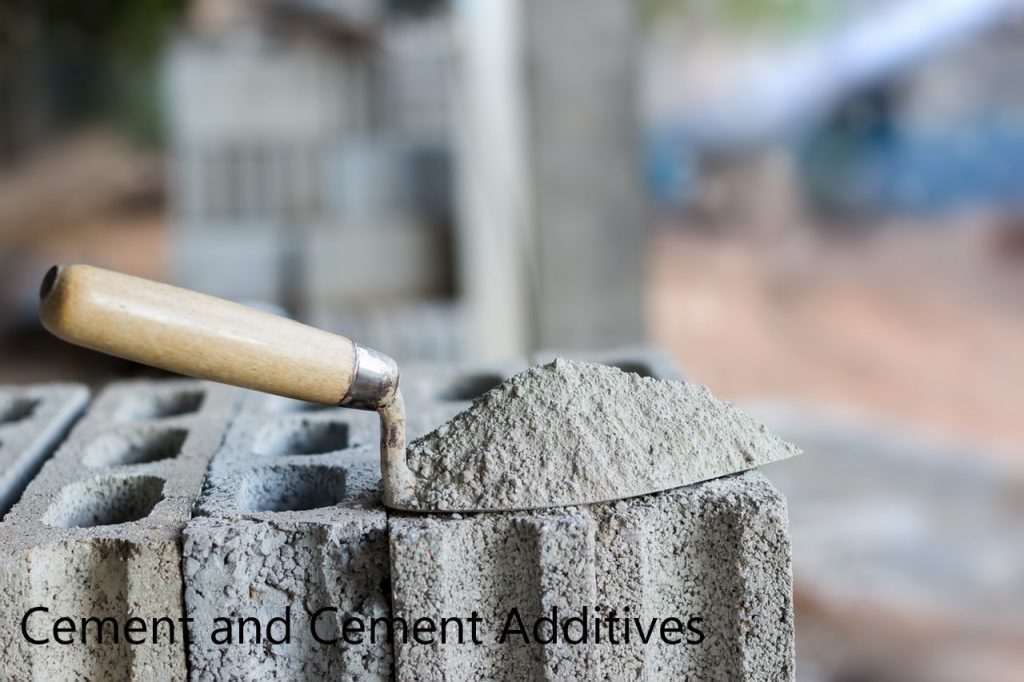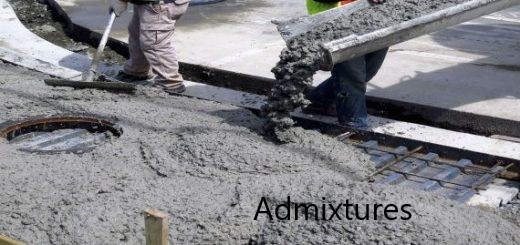Deterioration of concrete which is a durable issue affects the service life of a structure. Deterioration of the concrete leads to many consequences and even leads to the collapse of the structures.
Therefore, it is required to pay the fullest attention to the structure at the design stage, construction stage, and during service. Even if we build the structure with good technology using perfect design, a lack of attention to the condition of the structure during its service life led to its failure of the structure.
The durability of the structure is connected to many. The main concerns of the durability of the concrete or concrete deterioration are corrosion of reinforcement, the chemical attack on concrete, alkali-aggregate reactivity, abrasion/erosion, fire/heat, restraining to volume change, overload, impacts loads, loss of supports, surface defect.
let’s discuss each defect in brief.
Corrosion of Reinforcement
Corrosion of reinforcement is directly related to the cracking of the concrete. Concrete cracking exposes the reinforcement to a corrosive environment.
Reinforcement starts corroding with the presence of oxygen and moisture. If we can avoid that, corrosion reinforcement can be avoided. In addition, there are other methods of corrosion or reinforcement too. They are not that common.
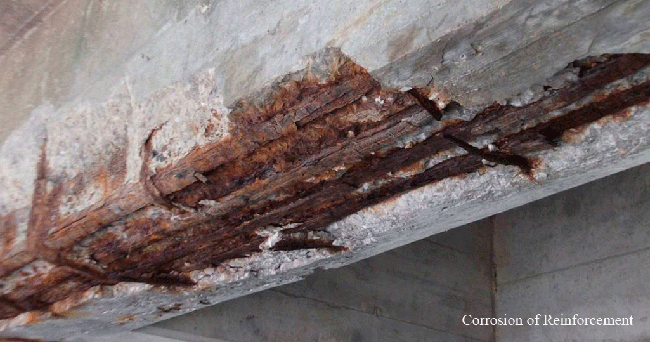
Let’s see what the common causes of corrosion of reinforcement are
Chloride Attack
Chloride ions (CL-) are created when substances like hydrogen chloride are dissolved in water or when the element chlorine obtains an electron. Chloride ions present in concrete in high concentrations might cause serious issues. Chloride ions dissolve the passive layer of steel reinforcement due to their electrochemical nature, which eliminates the need to lower pH levels. Corrosion occurs when chloride ions interact with passive materials like steel and the environment to trigger a chemical reaction that results in the formation of hydrochloric acid. The steel reinforcement is destroyed by hydrochloric acid, which causes cracking, spalling, and ultimately failure of the concrete.
Carbonation of Concrete
Carbonation is the result of the reaction between the calcium hydroxide in the cement paste and the carbon dioxide in the air. Calcium carbonate is created in this reaction, which also brings the pH down to about 9. At this point, corrosion becomes conceivable because the protective oxide layer surrounding the reinforcing steel degrades. Because carbon dioxide and calcium hydroxide can only react in solution, carbonation in dry concrete will be slow. In saturated concrete, moisture creates a barrier that prevents carbon dioxide from penetrating, therefore carbonation will again be slow. When there is just enough moisture for the carbonation reaction to occur but not enough to create a barrier, this is the ideal situation.
Dissimilar Metal Corrosion
An electrode potential is created when two different metals come into contact; this electrode potential depends on the two metals and the electrolyte that is present, among other things. Generally speaking, the bigger the electrode potential or the farther apart the two metals are in the electrochemical series, the more bimetallic corrosion there will be. However, electrode potential may vary as a result of the production of oxide layers and cannot be utilized in isolation to predict whether and to what extent bimetallic corrosion will occur.
Freeze-Thaw Deterioration
Low temperatures cause water that is trapped in the pores of cement paste to freeze. Given that ice takes up more space than water when it freezes, expansion forces may be produced if the pores are almost filled with water, or if the concrete is saturated. When the expansive pressure caused by freezing exceeds the concrete’s local strength, damage results.
Cracks appear in an arbitrary pattern on the concrete’s surface. The expansive pressure may cause surface disintegration or scaling to the depth that freezing conditions have already reached. Progressively more extensive damage results from freezing and thawing cycles.
Deicer Scaling
Slag cement-based concrete typically demonstrates good long-term strength and durability qualities. The deicer scaling resistance of concrete containing slag, particularly when the dosage of slag exceeds 50% of the total cementitious material in the mixture, has drawn some concern. Even if there are signs that these combinations frequently function well in the field, a lot of the anxiety seems to be based on the outcomes of laboratory scaling tests based on ASTM C 672.
Aggregate Expansion
Some aggregates may absorb so much water that they are unable to withstand the hydraulic pressure and expansion that result from freezing water. If enough problematic particles are present, the result would be an expansion of the aggregate and perhaps the disintegration of the concrete. A pop-out may occur if a problematic particle is present close to the concrete’s surface.
Chemical Attack
Concrete stands well when subjected to different air conditions, water, soil, and several chemical exposures.
Even high-quality concrete can decay in some chemical conditions, though. Aggressive chemicals need to be in solution and at a certain minimum concentration to significantly attack concrete.
Acids
Acid resistance in portland cement concrete is often poor. In reality, if exposed to a solution with a pH of 3 or below, no hydraulic cement concrete, regardless of its composition, will endure for very long.
However, if the exposure is just sometimes, some mild acids can be tolerated. Portland cement concrete typically needs to be protected from acidic conditions using surface protective treatments to prevent deterioration from acid assault. Siliceous aggregates, in contrast to limestone and dolomitic aggregates, are acid-resistant and are occasionally requested to increase the chemical resistance of concrete, particularly when chemical-resistant cement is used. A well-cured concrete’s reduced permeability makes it more resistant to acid assault.
Salts and Alkalis
Concrete deterioration is caused by the chlorides and nitrates of ammonium, magnesium, aluminum, and iron, with those of ammonium causing the most harm. Because they produce ammonia gas and hydrogen ions in the alkaline environment of concrete, the majority of ammonium salts are harmful. By removing calcium hydroxide from the concrete, they are replenished. As a result, there is a leaching reaction that resembles an acid attack. The disintegration of concrete can also be brought on by strong alkalies (above 20%).
Sulfate Attack
There are instances where groundwater or soil contains naturally occurring sodium, potassium, calcium, or magnesium sulfates. Sulfates can damage concrete by interacting with the hydrated cement constituents during hardening. These reactions have the potential to create enough pressure to break apart the cement paste, which would reduce cohesiveness and strength. Ettringite is created when calcium sulfate attacks calcium aluminate hydrate. Ettringite and gypsum are produced when sodium sulfate combines with calcium hydroxide and calcium aluminate hydrate. Ettringite, gypsum, and brucite are produced when magnesium sulfate assaults in a way similar to that of sodium sulfate (magnesium hydroxide). The majority of the concrete’s surface is where brucite forms, consumes calcium hydroxide to bring the pH of the pore solution down and then breaks down calcium silicate hydrates.
Alkali-Aggregate Reactivity
Aggregates are generally chemically inert in concrete. However, some aggregates expand and break over a long period when exposed to the alkali hydroxides in concrete. Alkali-silica reaction (ASR) and alkali-carbonate reaction are the two types of this alkali-aggregate reaction (ACR).
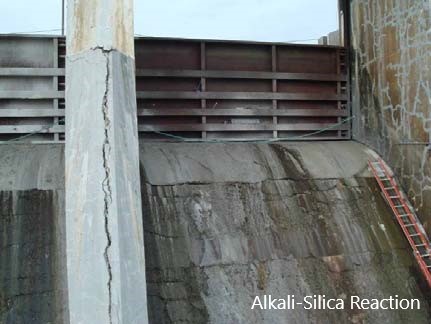
Alkali Silicate Reactivity
Because reactive silica-containing aggregates are common, alkali-silica reaction (ASR) is a major issue. In ASR, concrete’s alkali hydroxide reacts with some types of silica-containing particles to create a gel that expands as it absorbs water from the surrounding cement paste or the environment. These gels can cause concrete damage with their expanding pressure.
Random map cracking and closed joints with accompanying spalled concrete are typical signs of ASR. Cracking typically develops in locations where moisture is present regularly, such as around waterlines in piers, close to the ground behind retaining walls, adjacent to joints and free edges in pavements, or in piers or columns prone to wicking activity. ASR can be identified with certainty via a petrographic investigation.
Alkali Carbonate Reactivity
ACR is a phenomenon that can be observed in certain dolomitic rocks. Dolomite dedolomitization, or its breakdown, is usually related to expansion. The brucite reaction and subsequent crystallization could result in significant growth. Alkali-carbonate reactions (ACR) are very uncommon since the aggregates that are vulnerable to this phenomenon are less prevalent and typically inappropriate for use in concrete for other reasons. Nevertheless, the deterioration produced by ACR is identical to that caused by ASR. Petrographers can recognize the distinctive texture of aggregates that are prone to ACR. Contrary to the alkali carbonate reaction, the introduction of additional cementing materials does not stop harmful expansion brought on by ACR. Concrete should not contain ACR-vulnerable aggregates, it is advised.
Abrasion / Erosion
Abrasion and erosion of concrete is not common issue in concrete. They depend on the purpose of the use of concrete. In roads, car parks, ramps, etc. abrasion could lead to the deterioration of the concrete.
Thus, the abrasion of concrete is common in the concrete exposed to traffic.
On the other hand, the erosion of concrete is mainly due to water movement. Continues water flowing or frequent water flowing could lead to the erosion of concrete. When the speed of the water flow is fast, the erosion of concrete could be higher.
Hydraulic structures like spillways, cannel, etc., can be observed. A higher grade of concrete is used to reduce the abrasion/erosion of concrete.
Concrete Deterioration Due to Fire / Heat
A fundamental requirement of building design to ensure the safety of its occupants is the implementation of suitable fire safety systems. One of the most destructive factors that contribute to the deterioration of reinforced concrete structures is damage brought on by the fire. Despite being a noncombustible substance, concrete loses some of its physical, chemical, and mechanical qualities when exposed to high temperatures. The size and length of the fire have a large role in determining how serious a fire is in concrete structures. The damage to the concrete members is probably going to be low if the fire was only moderately large and burning for a brief period. Similar to this, an event of greater size or one that lasts longer will likely do the most damage or perhaps bring down concrete buildings.
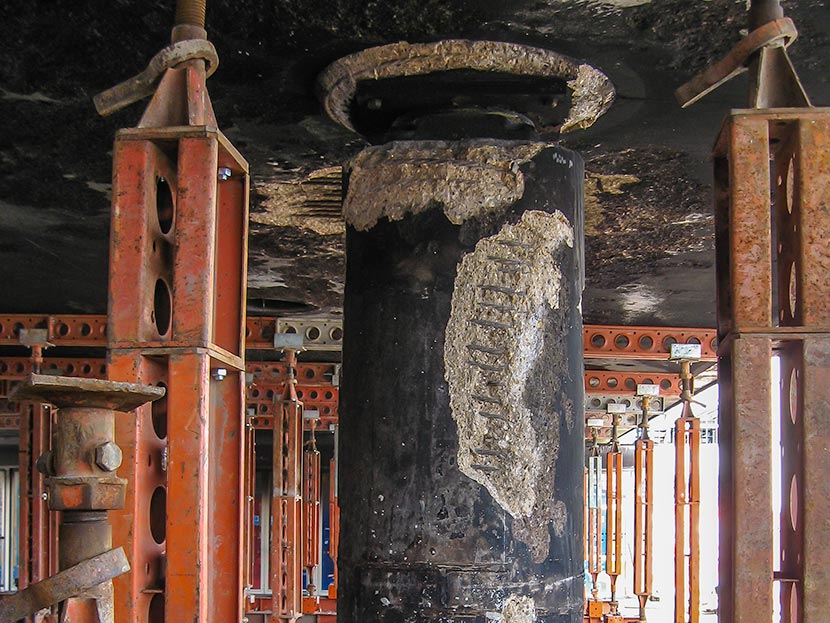
Cracking of Concrete Due to Restraining to Volume Change
Any material subjected to volume change due to its inherent properties or environmental impact. Similarly, concrete is also subjected to volume change from its initial stage to the service period.
Mainly there are two types of cracks that can be observed due to the restrains to the volume change.
Drying Shrinkage Cracking
The contraction of a hardened concrete mixture as a result of capillary water loss is known as drying shrinkage. Before the concrete is stressed, shrinkage increases the tensile stress, which results in cracking, internal warping, and external deflection. As Portland cement concrete ages, it all experiences drying shrinkage or hydrate volume change. For the engineer designing a structure, the hydral volume change in concrete is crucial. Slabs, beams, columns, bearing walls, prestressed members, tanks, and foundations are all susceptible to drying shrinkage.
Several variables affect drying shrinkage. These variables include the member size, member characteristics, component proportions, mixing technique, moisture content during curing, and dry atmosphere. Normal curing conditions cause some volumetric change in concrete. The main causes of drying shrinkage are the water in cement paste and the evaporation of capillary water. The effects of drying shrinkage are more pronounced the more water there is in the fresh concrete. The amount of mixing, the period that has passed since the water addition, temperature changes, slumping, placing, and curing all affect how much concrete will shrink. Concrete composition is also crucial. Each type of cement and aggregate has unique qualities that each affect how much concrete shrinks.
Concrete drying shrinkage is influenced both directly and indirectly by the amounts of water and admixtures used during mixing. The main cause of concrete shrinkage is the evaporation of the capillary water used in mixing. The size, location, and temperature of the construction, as well as the physical characteristics of the concrete, all affect how much shrinkage occurs.
Thermal Cracking
Various parts of a concrete structure may lose heat from hydration at different rates, or the weather may cool or heat one part of the building to a different degree or at a different rate than another, which can result in temperature differences within the structure. Cracks are caused by the differential volume change brought on by these temperature changes. This is frequently connected to mass concrete, such as huge and thicker parts of columns, piers, beams, footings, and slabs. Any structure may be impacted by a temperature differential brought on by changes in the ambient temperature.
Due to the release of heat during cement hydration, the center of the concrete may heat up more than the exterior, or the exterior may cool more quickly than the interior, depending on the reason for the temperature gradient. In either scenario, the exterior will experience tensile stresses, and cracking will develop if the tensile strength is exceeded. The tensile stresses are related to temperature difference, thermal expansion coefficient, effective modulus of elasticity (which is lowered by creep), and degree of constraint. The possibility for temperature difference and constraint increases with structure mass. The coefficient of thermal expansion of hardened concrete can vary from 4 to 9×10-6 per degree Fahrenheit.
The possibility of thermally induced cracking arises when one area of a structure experiences a temperature-driven volume change. Structures that have certain parts exposed to temperature changes while having other parts that are either entirely or partially shielded should be given extra thought when designing them. The exposed element may crack as a consequence of a temperature reduction, whereas the shielded area of the structure may break as a result of a temperature rise.
Surface Defects
Concrete surface defects could lead to durability issues. They are mostly connected to the issues discussed above also. The uneven concrete surfaces could lead to cracking than smooth surfaces due to their irregularity.
In addition, the following are some of the issues that lead to the deterioration of concrete.
- Honeycombs
- Un-repaired tie holes
- Cold joints
- Form offsets
- Sand streaking
- Form Streaks
All the mention above defect needs to add during the construction stage. Some of them are not only affecting the deterioration of concrete, but they also affect structural stability. Honeycombs, cold joints, etc. are structural concern defects that we must take action on.

